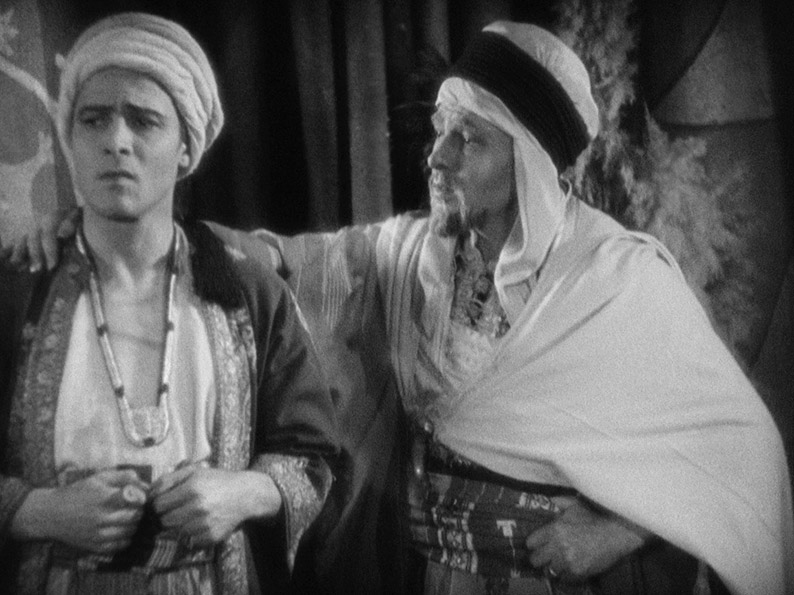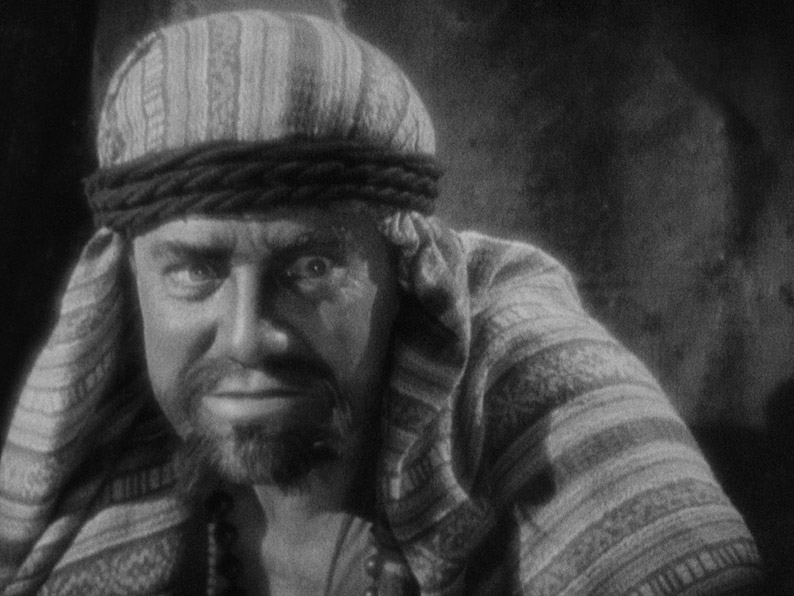|
I have to confess that until recently I didn't know that much about silent era superstar, Rudolph Valentino. I have a sneaking suspicion that I may have seen his phenomenally successful 1921 The Sheik in my younger days, but it was just too long ago now to be sure. I've read no books or major articles about him, and the 1977 biopic Valentino is one of only a small number of Ken Russell films that I've somehow never got around to seeing. Of course I've known who he is for as long as I can remember. How could I not have? Such is his fame as one of the defining movie icons and sex symbols of his day that his name is known even by those who have no interest in cinema, despite the fact that he died over 90 years ago. Now that, ladies and gentlemen, is a legacy.
I thus felt obliged to do a little research on the man before embarking on a review of his final film, The Son of the Sheik, a follow-up to the aforementioned The Sheik that is credited as being one of the first movie sequels. Ah, those were the days. I was aware that the world lost Valentino at a preposterously young age, but not that he died due to complications from peritonitis just two weeks before the opening of this film. I was also blissfully unaware that his real name was (deep breath) Rodolfo Alfonso Raffaello Pierre Filiberto Guglielmi di Valentina D'Antoguella. Women adored him, but in a glum indication of the sort of xenophobic nonsense that seems to be in the resurgence, he was considerably less popular with their menfolk, who regarded this Italian sex symbol as a threat to their American manhood, conveniently forgetting that a fair number of them were also of Italian descent. His premature death (he was only 31, for pity's sake) devastated his by-then huge fanbase, and they were unable to get into his Manhattan funeral. A riot broke out that took over 100 mounted policemen and every available NYPD reservist a good part of the day to quell. The news of his death even prompted three of his most ardent and broken-hearted female fans to take their own lives. He simply has no equivalent today.

You don't need to have seen The Sheik to make sense of its belated sequel, though it's not a bad idea to either track it down or at the very least read a synopsis of the plot before sitting down for The Son of the Sheik. In this film, young Ahmed (Valentino), the son of the first film's Sheik Ahmed Ben Hassan is captivated by a French dancing girl named Yasmin (Vilma Banky), who is part of a morally suspect troupe and under the control of her exploitative father, who has promised her to the villainous Ghabah (Montague Love). Ahmed and Yasmin start seeing each other in secret, but when Ahmed is captured for ransom and tortured by Ghabah and his men, Ghabah poisons the romance by telling Ahmed that the whole thing was a setup and that he is far from the first man that Yasmin has helped them to snare.
The fact that The Son of the Sheik is an 68 minute-long, star-driven Hollywood romantic drama made during the silent era should be excuse enough for a plot that doesn't have much more to it than the above, plus an ending you'll be able to predict from the moment Ahmed first claps eyes on Yasmin. That's not meant as a criticism, just an acknowledgement of the way these things often were in their day, and here it's all about the cast and the execution. Valentino proves to be every bit the charmer of legend, and when Ahmed and Yasmin kiss in gorgeously lit closeup in the isolated ruins of a building, there's a sexual charge to the scene that just for a brief moment had me questioning my heterosexuality. That said, he's well matched by Vilma Banky, who sports that silent era innocent heroine look – pale skin, frizzy hair, vampish eye makeup and dark kissy lipstick – that enabled Lillian Gish to cast a spell on me in my early teens.
Inevitably, some elements have not aged as comfortably as others, particularly when Ahmed, wrongly believing he has been tricked by Yasmin, kidnaps her and forces himself upon her, an assault that begins with her violently resisting his aggressive kisses and ends with a fadeout that seems to signal the onset of a rape. The fact that the most diminutive member of the Ghabah's gang (played by Russian actor Bynunsky Hyman) is the film's comic relief has a too-familiar "he's short so he's funny" ring, though the similarity of one humiliation inflicted on him to his contribution to Ahmed's torture does give that moment an air of unexpected poetic justice. The racial politics (Ahmed and Yasmin are European while Ghabah is a Moor and his gang are all Arabs) are not as wincingly crude as they were in the first film, and the fact that every Arab in the film is played by a white actor is par for the Hollywood course in its day, though any whiff of cultural sensitivity is absent from the decision to name one of Ahmed's Arabic bodyguards Ramadan.

Ultimately, however, the socio-political foibles of The Son of the Sheik do not seriously impact on what was always designed as a straightforward mainstream slice of film entertainment, and on that score it delivers with some aplomb. The lead players are engaging, the supporting cast enjoyable, the pacing brisk, the cinematography (by George Barnes of Rebecca, Spellbound and Force of Evil fame) is luminous and expressive, the art direction by the legendary William Cameron Menzies is handsome, and the brief running time doesn't give the threadbare plot a chance to wear out its welcome. A climactic fight that pits Ahmed, his men and his father against a hoard of Ghabah's goons does the job without being particularly memorable, with the swordfight choreography simplified to having everybody just slash rapidly side-to-side or spin their swords in circles until somebody falls down.
What does impress for a 1926 film are the optical effects, a couple of which seem almost to have been set up just to allow the technical crew to show off their skills. With Valentino cast as both Ahmed and his father, the easiest move would have been to stick to cutting from one to the other when they meet, but director George Fitzmaurice and his crew clearly had higher ambitions. In shots in which they converse in the same frame, the join between the two images is invisible even in HD, but in a demonstration of strength that may or may not have been borrowed from the Sherlock Holmes story The Speckled Band, Ahmed's father bends a metal bar and throws it at the feet of his son, who then picks it up and straightens it and I genuinely found myself wondering how this effect was achieved.* Seemingly determined to push this technique to its limit, Fitzmaurice then has Valentino as the father put his arm round Valentino as Ahmed and rest his hand on Ahmed's far shoulder. The technique is certainly more visible here (a later one in which the two are fighting side-by-side is a lot less successful), but on a first viewing it genuinely knocks you for six, and stands as a handy reminder of just how rapidly the film art was evolving in an era in which this pace of artistic and technical development was, a tad ironically, soon to be slowed by the technical constraints that came with recording of synchronised sound.
Framed in its original aspect ratio of 1.33:1, the restored picture on 1080p HD transfer on the Blu-ray in this dual format set is a good one. There's a slight softness to the image that has to be down to the material used for the restoration (it's a 94-year-old film, after all), but the contrast range is attractive and there's no crushing of blacks or burned-out highlights, and the picture is clean of dust and damage and sits solidly in frame with no visible jitter. There is some very faint flickering in some scenes, but it's never obtrusive, and a fine film grain is present throughout.

The film is accompanied by a new orchestral score by Carl Davis, which is well matched to the action and even provides the occasional sound effect (a snare dram hit for gunshots, a horn for a wailing voice) and can be played either in DTS-HD Master Audio 5.1 surround or Linear PCM stereo 2.0. Frankly, both sound terrific, the only real difference being an occasional subwoofer kick to the bass notes and a subtle use of the surround speakers on DTS track.
Loitering Within Tent (24:01)
A ha-ha title (which I'm not going to criticise as it's one I would have happily used for this review had it not already been taken) for another detailed and engaging video essay by writer and critic David Cairns, who opens with a wonderfully overlapping recital of a Dick Dorgan Photoplay piece on why men hate Valentino before examining the film as a pop culture artefact. He neatly describes the original The Sheik as "a strange, offensive work…50 Shades of Grey for the jazz age," and goes on to examine the genesis of this sequel and its production, as well as providing interesting analysis of some of its key components. I particularly liked his claim that "eroticism is racism's sexy sister." It ends with an audio recording of Valentino singing.
Introduction to The Son of the Sheik by Orson Welles (17:35)
From a series titled The Silent Years in which Welles introduces "films from the collection of Paul Killiam," this intro includes lengthy extracts from some early Valentino works in which he plays prominent supporting roles. The image and sound quality are less than ideal, but for Valentino newcomers especially the content still makes this a most worthwhile watch.
Booklet
Credits, technical specs and imagery aside, the whole booklet is given over to a thoroughly researched and engrossing essay by writer, critic and blogger on silent cinema Pamela Hutchinson, which takes a detailed look at the film and its production and nicely describes it as having "a beautiful surface and several sordid secrets, much like its much-gossiped-about leading man."
What The Son of the Sheik lacks in plot complexity, character depth and cultural sensitivity it makes up for in the pace, sweep and technical proficiency of its execution and the undeniable charm of its two leads, and as the final film of one of the most iconic stars of the silent era it's without question an important work. A solid restoration and transfer, and while the disc is a tad extras-light for a Masters of Cinema release, what has been included is good, and this thus comes recommended.
|